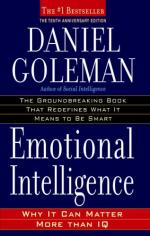
|
| Name: _________________________ | Period: ___________________ |
This test consists of 5 short answer questions, 10 short essay questions, and 1 (of 3) essay topics.
Short Answer Questions
1. Corporate consultant and psychoanalyst Harry Levinson advises managers on how to coach employees. What is the first piece of advice he gives?
2. According to an example in “Part Three: Chapter 9, “Intimate Enemies,” when boys play a sports game and one gets injured, the injured is expected to do what?
3. What does “SEL” stand for?
4. Dr. Judith Lewis Herman discovered three vital stages for retraining the brain of people suffering from PTSD. What is the second stage discussed in Part Four: Chapter 13, “Trauma and Emotional Relearning”?
5. According to the author in “Part Three: Chapter 11, Mind and Medicine,” various studies prove that helping people manage their emotions is a form of what?
Short Essay Questions
1. What three toxic parenting styles are described in Part Four: Chapter 12, “The Family Crucible”? Who identified these styles?
2. What does the author state in regard to personal prejudice in the workplace in Part Three: Chapter 10, “Managing with Heart”?
3. What growing movement in education is described by the author in Part Five: Chapter 16, “Schooling the Emotions”?
4. What impacts do stress and anxiety have on the body, according to Bruce McEven?
5. Why do parents have the greatest influence in shaping a child’s brain, according to the author in Part Four: Chapter 14, “Temperament Is Not Destiny”?
6. What is the author’s position in teaching “character”? What is his conclusion in this regard at the end of the book?
7. What discovery did Dr. David Spiegel make regarding emotions and the body?
8. What did Richard Davidson discover as a link to temperament? How is this link described in Part Four: Chapter 14, “Temperament Is Not Destiny”?
9. What example does the author give in Part Three: “Chapter 9, Intimate Enemies” for the differences between boys and girls in their interpersonal relationships?
10. What can cause post-traumatic stress disorder in children? What makes a difference in a child’s ability to overcome PTSD?
Essay Topics
Write an essay for ONE of the following topics:
Essay Topic 1
Discuss the work of Dr. Peter Sifneos and the condition of alexithymia. When was this condition identified? What characteristics do alexithymics exhibit? How are they perceived by others?
Essay Topic 2
Discuss the work of Paul Ekman and describe the three display rules described by Ekman in Part Two: Chapter 8, “The Social Arts.” What are examples of each of these rules? What dictates the display of each emotion?
Essay Topic 3
Describe and analyze the relationship between psychopathic individuals and empathy. How does William Pithers suggest psychopaths can learn empathy? What examples does he use? Are there opposing viewpoints to his findings?
|
This section contains 897 words (approx. 3 pages at 300 words per page) |

|




